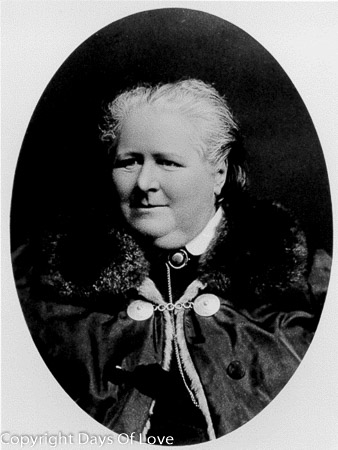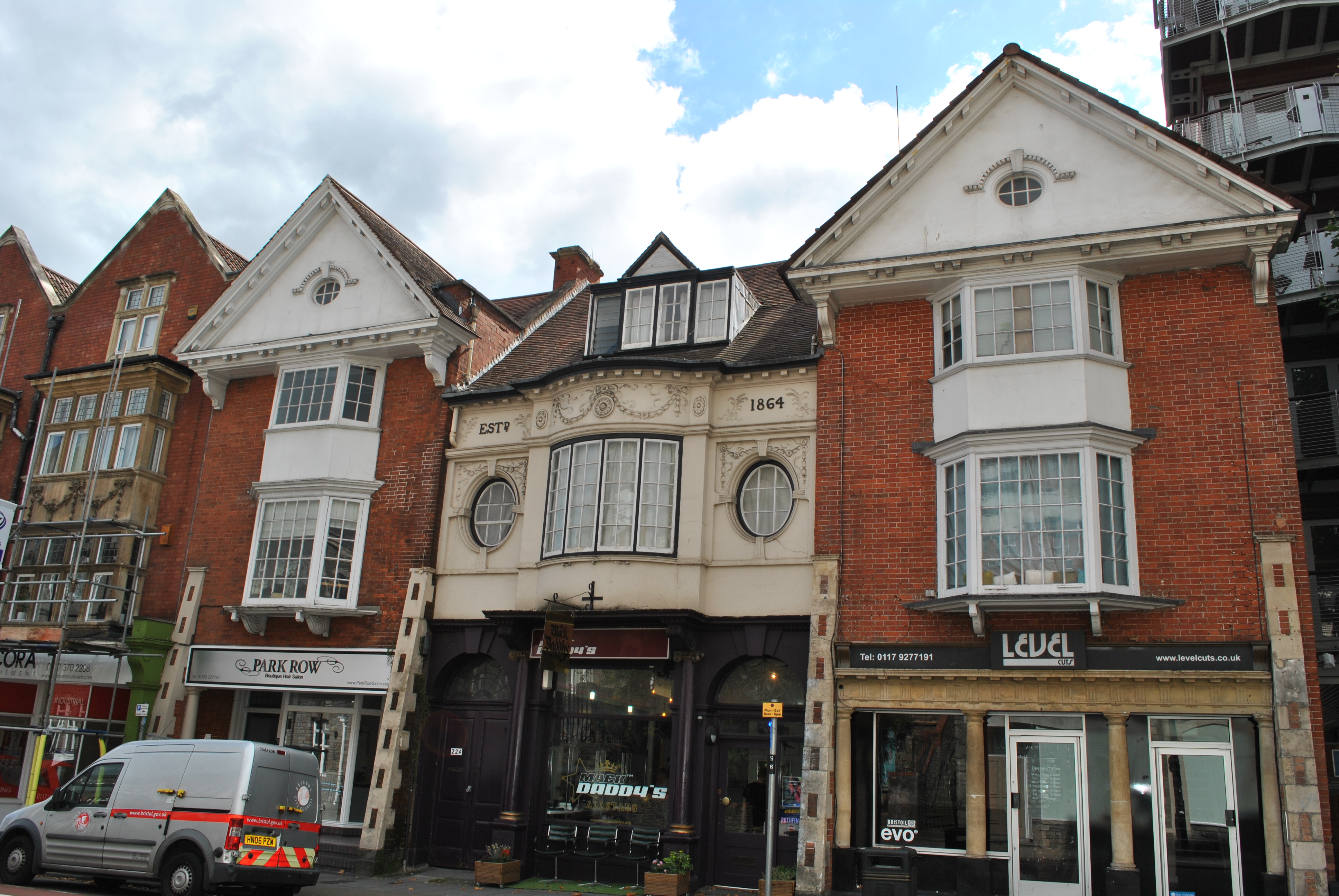BURIED TOGETHER
Partner Mary Lloyd, buried together
Queer Places:
(1866) 26 Hereford Square, Kensington, London
SW7, UK
Newbridge House, Newbridge Demesne, Donabate, Co. Dublin, Irlanda
Miss Poggi's School, 32 Brunswick Terrace, Hove BN3 1HJ, UK
15 Connaught Square, London W2 2HG, UK UK
26 Hereford Square, South Kensington, London SW7 4TS, UK
1 Park Row, Frampton Cotterell, Bristol BS36 2BS, UK
The Red Lodge Museum, Park Row, Bristol BS1 5LJ, UK
Tan Llan, Llanelltyd, Dolgellau LL40 2ST, UK
Tyn-y-Celyn, Llanelltyd, Dolgellau LL40 2TA, UK
St Illtud, Dolgellau LL40 2ST, UK
Kensal Green Cemetery, Harrow Rd, London NW10 5NU, UK
 Frances
Power Cobbe (4 December 1822 – 5 April 1904) was an Irish writer, social
reformer, anti-vivisection activist, and leading women's suffrage
campaigner. She founded a number of animal advocacy groups, including the
National Anti-Vivisection Society (NAVS) in 1875, and the British Union
for the Abolition of Vivisection (BUAV) in 1898, and was a member of the
executive council of the London National Society for Women's Suffrage.
There was no law in Britain governing adoption until 1926. Her name and picture (and those of 58 other women
and men's suffrage supporters)
are on the
plinth of the
statue of
Millicent Fawcett in
Parliament Square, London, unveiled in 2018.
Frances
Power Cobbe (4 December 1822 – 5 April 1904) was an Irish writer, social
reformer, anti-vivisection activist, and leading women's suffrage
campaigner. She founded a number of animal advocacy groups, including the
National Anti-Vivisection Society (NAVS) in 1875, and the British Union
for the Abolition of Vivisection (BUAV) in 1898, and was a member of the
executive council of the London National Society for Women's Suffrage.
There was no law in Britain governing adoption until 1926. Her name and picture (and those of 58 other women
and men's suffrage supporters)
are on the
plinth of the
statue of
Millicent Fawcett in
Parliament Square, London, unveiled in 2018.
Well-known
single women adopted babies, including
Christabel Pankhurst,
Emmeline Pankhurst and
Elizabeth Robins.
Elizabeth Blackwell and
Frances Power Cobbe are
examples among earlier feminists.
Frances Power Cobbe wrote in her autobiography of how the married
Mary Somerville, a good
friend but never a lover, “kissed me tenderly [and] gave me her
photograph”; Cobbe in turn felt “such tender affection” for Somerville
“that sitting beside her on the sofa . . . I could hardly keep myself from
caressing her.”
When Cobbe published a widely read autobiography in 1894, she included a
photograph of the house she lived in with sculptor
Mary Lloyd.
Throughout the book, references to joint finances and travels, to “our
friends,” “our garden,” and “our beautiful and beloved home” treated
Cobbe’s conjugal arrangement with Lloyd as a neutral public fact, one
Cobbe expressed even more clearly in letters to friends in which she
called Lloyd both her “husband” and her “wife.”
The social network that
embraced the two women included Fanny Kemble,
John Stuart Mill, Henry Maine, Charles Darwin, and William Gladstone, many
of whom recognized that Cobbe and Lloyd formed a conjugal unit who lived
and traveled together and were to be jointly saluted in correspondence and
invited as a pair to social gatherings. Renowned actress Kemble, who
published several autobiographical works during her lifetime, openly
discussed Cobbe and Lloyd as a couple.

1 Park Row, Frampton Cotterell, Bristol

St Illtud, Llanelltyd
Cobbe was the author of a number of books and essays, including The
Intuitive Theory of Morals (1855), On the Pursuits of Women
(1863), Cities of the Past (1864), Criminals, Idiots, Women and
Minors (1869), Darwinism in Morals (1871), and Scientific
Spirit of the Age (1888).
Frances was a member of the prominent Cobbe family, descended from
Archbishop Charles Cobbe, Primate of Ireland. She was born in Newbridge
House in the family estate in what is now Donabate, Co. Dublin.[1]
Frances worked at the Red Lodge Reformatory and lived with the owner,
Mary Carpenter,
from 1858 to 1859, but a turbulent relationship between the two meant that
Frances left the school and moved out.[2]
Frances Power Cobbe made
several excursions to Italy between 1857 and 1862. In Rome Cobbe met not
only Harriet Hosmer but a Welsh
sculptor, Mary Lloyd, who had
studied and worked with Rosa
Bonheur. When Cobbe, introduced by Lloyd, visited the French artist,
she reported: ‘Nothing I liked about her, so much, however, as her
interest in Hattie Hosmer, and her delight in hearing about her Zenobia
(triumphans) in the Exhibition.’ Cobbe and Lloyd returned to London in
1862 for what was to become a thirty-year partnership. Hosmer stayed with
the couple on her visits to Britain, and joined them in support of women’s
enfranchisement: Hosmer, Cobbe and Lloyd were members of the London
National Society for Women’s Suffrage in the late 1860s.
Charlotte Cushman held her
first reception in her new home in January of 1859, beginning a tradition that
would continue for many years. Mingling at this festive event were the
feminist art historian Anna Jameson, Fanny Kemble,
Adelaide Sartoris, and the British author and reformer
Mary Howitt, to name just a few. When the Irish feminist
Frances Power Cobbe came to town, she noted: There was a brightness, freedom and joyousness among these gifted Americans, which was quite delightful to me. Cushman had the gift of drawing out the best from all who came, explained
Emma Crow, the youngest daughter of the philanthropist Wayman Crow.
American women sculptors’ relationship with the colonialist discourse in
Italy was fraught with such contradictions. Nonetheless,
Frances Power Cobbe, who lived at
the
Charlotte Cushman domicile in
the early 1860s, promoted the notion of Rome as a utopia. Italy seemed “the
favorite land of gifted Americans,” she exclaimed. “American women, in
particular, seem to find it a congenial sphere for the development of the
more marked individuality which characterizes them.”
She formed a marriage with the Welsh sculptor
Mary Lloyd, whom she met in
Rome in 1861 and lived with from 1864 until Lloyd's death. Mary’s death in
1896 affected Frances badly. Her friend, the writer Blanche Atkinson,
writing, “The sorrow of Miss Lloyd’s death changed the whole aspect of
existence for Miss Cobbe. The joy of life had gone. It had been such a
friendship as is rarely seen – perfect in love, sympathy, and mutual
understand.”
[3] They are buried together at Saint Illtud Church Cemetery,
Llanelltyd, Gwynedd, Wales.[4]
In letters and published writing, Frances referred to Lloyd alternately as
"husband," wife," and "dear friend."[5]
Frances founded the Society for the Protection of Animals Liable to
Vivisection (SPALV) in 1875, the world's first organisation campaigning
against animal experiments, and in 1898 the BUAV, two groups that remain
active. Frances was a member of the executive council of the London
National Society for Women's Suffrage and writer of editorial columns for
London newspapers on suffrage, property rights for women, and opposition
to vivisection. Around 1880, with Louise Twining, Frances founded Homes
for Workhouse Girls.[6]
Frances met the Darwin family during 1868. Emma Darwin liked her, "Miss
Cobbe was very agreeable." Frances persuaded Charles Darwin to read
Immanuel Kant's Metaphysics of Ethics.[7]
She met him again during 1869 in Wales, and apparently interrupted him
when he was quite ill,[8]
and tried to persuade him to read John Stuart Mill—and indeed Darwin had
read Frances's review of Mill's book, The Subjection of Women.[9]
She then lost his trust when without permission she edited and published a
letter he'd written to her.[8]
Her critique of Darwin's Descent of Man, Darwinism in Morals
was published in The Theological Review in April 1871.[10][11]
In the first edition of her autobiography, published in 1894 while
Lloyd still lived, Cobbe ended her story on a note of conjugal triumph,
explaining that a recent legacy had made it possible for the couple to
live in the family home they had previously been forced to rent out: “I
have rejoiced that the comfort and repose of our beautiful and beloved
home is secured to my friend and myself.” Cobbe bid her readers goodbye
noting that they left her “in this dear old house, and with my beloved
friend for companion.”
When Lloyd died in 1896, Cobbe sent
Rosa Bonheur a photograph of
herself with Lloyd and their dog; Bonheur, who had recently lost Nathalie Micas,
responded with a photo of herself with Micas and their dog.
In an article published in Contemporary Review in 1900, Cobbe called
Lloyd her “life friend,” and her autobiography invoked the marital
privilege of privacy to explain why she wrote sparingly about Lloyd: “Of a
friendship like this . . . I shall not be expected to say more.”
The 1904 edition of her Life, published after both Lloyd and Cobbe were
dead, included an introduction that cited Cobbe’s account of asking
Lloyd’s permission to write an autobiography, along with Lloyd’s request
for “reticence.”
Her name is listed on the south face of the Reformers Memorial in
Kensal Green Cemetery in London. A portrait of her is included in the mural of heroic women by Walter P.
Starmer unveiled in 1921 in the church of St Jude-on-the-Hill in Hampstead
Garden Suburb, London.
My published books:


BACK TO HOME PAGE

- https://en.wikipedia.org/wiki/Frances_Power_Cobbe
- Marcus, Sharon. Between Women (pp.1-2). Princeton University
Press. Edizione del Kindle.
- Rossini, Gill. Same Sex Love 1700-1957: A History and Research
Guide . Pen and Sword. Edizione del Kindle.
- Crawford, Elizabeth. The Women's Suffrage Movement (Women's and
Gender History) (p.134). Taylor and Francis. Edizione del Kindle.
- Dabakis, Melissa. A Sisterhood of Sculptors . Penn State
University Press. Edizione del Kindle.
- Cherry, Deborah. Beyond the Frame (p.117). Taylor and Francis.
Edizione del Kindle.
-
https://www.geoffbrookes.co.uk/frances-power-cobbe/
 Frances
Power Cobbe (4 December 1822 – 5 April 1904) was an Irish writer, social
reformer, anti-vivisection activist, and leading women's suffrage
campaigner. She founded a number of animal advocacy groups, including the
National Anti-Vivisection Society (NAVS) in 1875, and the British Union
for the Abolition of Vivisection (BUAV) in 1898, and was a member of the
executive council of the London National Society for Women's Suffrage.
There was no law in Britain governing adoption until 1926. Her name and picture (and those of 58 other women
and men's suffrage supporters)
are on the
plinth of the
statue of
Millicent Fawcett in
Parliament Square, London, unveiled in 2018.
Frances
Power Cobbe (4 December 1822 – 5 April 1904) was an Irish writer, social
reformer, anti-vivisection activist, and leading women's suffrage
campaigner. She founded a number of animal advocacy groups, including the
National Anti-Vivisection Society (NAVS) in 1875, and the British Union
for the Abolition of Vivisection (BUAV) in 1898, and was a member of the
executive council of the London National Society for Women's Suffrage.
There was no law in Britain governing adoption until 1926. Her name and picture (and those of 58 other women
and men's suffrage supporters)
are on the
plinth of the
statue of
Millicent Fawcett in
Parliament Square, London, unveiled in 2018.


